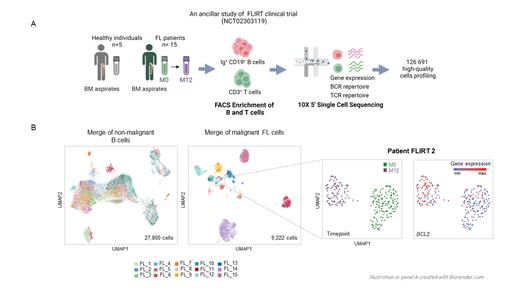Follicular Lymphoma (FL) remains a clinically challenging disease as most patients undergo a succession of clinical response/relapse cycles suggesting that current therapies do not eradicate residual tumor cells. Genetic studies suggest that FL relapses seed from a reservoir of rare Cancer Precursor Cells (CPCs), which likely remain resistant to treatment due to their homing to propitious niches such as the bone marrow (BM) and/or to the acquisition of a specific functional B-cell state. Yet, the rarity of such CPCs and the use of bulk sequencing technologies have so far hampered their direct characterization. Profiling CPC remains thus a major challenge in the FL field. Here, we identify and characterize FL cells before/after rituximab monotherapy within the BM of low tumor burden FL, looking for CPC-like cells supporting minimal residual disease.
We harnessed a unique collection of longitudinal BM aspirates from 15 newly diagnosed low-tumor burden FL patients enrolled in the phase III clinical trial FLIRT (NCT02303119) evaluating Rituximab monotherapy and sampled at diagnosis (M0) and at one-year post-treatment start (M12). We generated a multi-modal single-cell dataset combining gene expression, B-cell receptor (BCR) and T-cell receptor (TCR) repertoire (Fig1A). We used BCR sequence analysis as a pivotal method to assign the clonal malignant identity within variably infiltrated BM at diagnosis and track the clonally related residual disease FL cells at M12. We compared FL B cell transcriptional heterogeneity after rituximab therapy. We also integrated BM T cell transcriptomes from both timepoints to study compositional changes of the BM microenvironment linked to a B-cell depletion treatment.
We profiled 9,222 BM infiltrating FL cells. Single cell clustering showed a unique transcriptional signature for malignant cells of each FL patient, indicating a major inter-patient heterogeneity. By contrast, the non-malignant B cell clusters were mixed across patients and organized into transcriptional signatures encompassing normal B-cell differentiation steps (Fig1B, left). We then used unsupervised metaclustering of malignant B cells to uncover shared transcriptional states across patients, yielding 6 metaclusters (Mcl) expressing distinct gene expression programs. Mcl gene expression signatures observed in FL BM shared some similarities with the transcriptional programs observed in FL lymph nodes such as non-cycling Germinal Center-like (Mcl.1) or Mem-like (Mcl.3 and Mcl.4) states. This suggests that FL transcriptional heterogeneity is conserved between distinct niches. BM FL cells also upregulated several pathways, including glycolytic metabolism ( GAPDH), NF-κB signaling, negative regulators of cell cycle, or entry into quiescence programs.
By analyzing BM samples obtained at M12, we were able to track and profile very rare clonally-related FL cells in 80% of FL patients with a range of 2 to 65 residual FL cells per patient. Those residual FL cells present a heterogeneous cellular phenotype partly redundant with the transcriptional heterogeneity found at diagnosis indicating that residual cells cover a plurality of cell states whose links with clinical outcome is underway. Differential expression analysis in one case also revealed a transcriptional shift in residual FL cells (including overexpression of BCL2) compared to BM tumor cells at diagnosis (Fig1B, right), providing novel insights into putative CPC identity with possible implications for personalized therapies. Finally, exploration of the FL T-cell microenvironment revealed abundant TFH-like cells at diagnosis that were barely detectable in healthy donors. Interestingly, high frequency of the TFH-like subset was maintained at remission suggesting a potential role as a niche for therapy-resistant B cells and later relapses.
In summary, our single cell RNAseq analysis in the frame of a clinical trial provide the first longitudinal map of FL heterogeneity in the BM and characterize putative CPCs resistant to Rituximab-therapy. Ongoing efforts are now focusing on the microenvironment drivers of this intra-patient BM diversity and on specific molecular features of BM residual cells that could represent therapeutic vulnerabilities in this particular low-tumor burden FL population.
Disclosures
Nadel:BMS: Research Funding; diatech pharmacogenetics: Consultancy, Honoraria. Milpied:BMS: Research Funding. Brisou:Novartis: Consultancy. Cartron:MabQi, Ownards Therapeutics, Abbvie, Roche, Bristol Myers Squibb: Membership on an entity's Board of Directors or advisory committees; MedxCell, Ownards Therapeutics, MabQi, Emercell, F. Hoffmann-La Roche Ltd, BMS, Abbvie: Consultancy; Jansen, Gilead, Novartis, F. Hoffmann-La Roche Ltd, BMS, Abbvie: Honoraria; MedxCell: Consultancy; Novartis: Honoraria; Roche: Consultancy, Honoraria; Ownards Therapeutics: Consultancy; Janssen: Honoraria; MabQi: Consultancy; AbbVie: Consultancy, Honoraria; Gilead: Honoraria; Emercell: Consultancy; BMS: Consultancy, Honoraria. Roulland:BMS: Consultancy, Other: Travel Support, Research Funding.


This feature is available to Subscribers Only
Sign In or Create an Account Close Modal